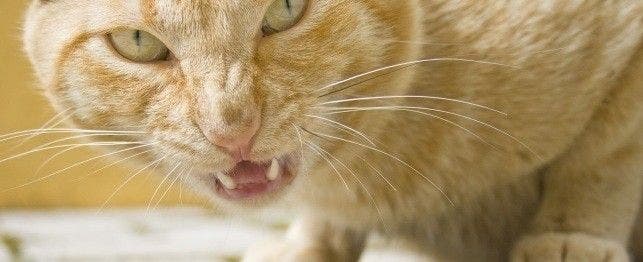
Maternal Aggression In Cats
What self-respecting mother would not do all within her power to protect and defend her offspring? Not too many. But sometimes these feelings of protectiveness turn into something called “maternal aggression” that can make a once-friendly pet unapproachable.
Some of this protectiveness arises out of affection and concern of a mother for her young. However, nature and alterations in brain chemistry both catalyze this response. The sight, sound and smell of the newborn, as well as tactile signals received during nursing, cause the release of a “bonding hormone,” oxytocin, which seals the mother-infant bond (and has other mechanical effects on the uterus and other smooth muscle tissues). In addition to this change, blood levels of progesterone, the hormone of pregnancy, fall rapidly as estrogen levels climb. The calming effect of progesterone is lost and the activating effect of estrogen replaces it. Also, and perhaps most significantly, the rise and fall of the milk releasing hormone prolactin exactly parallels that of maternal aggression.
This series of biological events, and the powerful emotions they cause, is responsible for maternal protectiveness, which, in an extreme situation, will show up as aggression. Maternal aggression occurs in all mammalian species, including horses, pigs, dogs, cats and others. It is not wise to approach a mare and foal without forethought, and it is risky to vault into a formerly friendly pig’s stall right after she has given birth. Likewise, some caution should be exercised working around recently whelped bitches and recently kittened queens.
It is possible that people who are familiar and non-threatening will receive diplomatic immunity, but unfamiliar people, familiar persons lacking the respect of their pet, and unwelcome members of the same or a different species, may be driven away in no uncertain terms.
The Cat
A friendly mutt that wanders too close to a cat with kittens may get batted by a fist full of claws, or find himself being backed down by the hissing, spitting fury of an agitated mom. But a wandering male cat tops the list of unwanted intruders. In nature, males will sometimes mass-murder kittens of a litter that they have not sired. There are selfish biological reasons for this behavior that revolve around the dissemination of the cat’s own genes, and queens know it. This is one of the reasons that female cats in the wild sometimes live in communities so that they can cooperatively guard their kittens from attack.
It seems that queens will do whatever it takes to protect and defend their young, even if this involves personal risk to them. A mother cat that risked her life over and over again to rescue her kittens from a blazing building provides an example of this altruistic mentality. Her instinct to move and thus save her kittens overcame a natural tendency to avoid fire and smoke. She was badly burned in the process but survived to tell the tale to her grandkittens!
Infanticide
Infanticide is an unpleasant variation on the theme of maternal aggression. When animals give birth to young and then find themselves in situations that are not conducive to rearing them, they will sometimes kill the whole litter. One cat forced to give birth behind a couch in a living room, threatened by the high traffic in the home and the continuous disturbance of two young children, killed her kittens one at a time until the whole litter was dead. It may seem something of a paradox but humans have been known to engage in this ultimate sacrifice, too. It is impossible to comprehend the suffering that precedes such sacrifice.
Infanticide is well known in laboratory rodents who kill their young if they have been handled too much or blooded. Presumably odors play a key role in triggering this fatal misapprehension and presumably this behavior has a biological precedent that favors long term healthful survival.
Conclusion
Nature and nurture combine to produce behaviors that are beneficial to the survival of individual and the species. Maternal aggression is a short-term behavioral trait that makes perfect sense when viewed from this perspective. Pups and kittens are helpless without their mother’s support and protection. To juice up a mother’s protectiveness and willfulness at this critical fostering time is a logical and functional arrangement.
Nature is always logical and predictable once you understand that its prime function is to ensure recycling of the animal’s genes. The role of nurture is a little less obvious, but nonetheless evident. Experience lubricates the machinery of mothering so more experienced moms make better moms. They learn instrumentally how best to look after and defend their newborn, building on and taking pleasure in success. There are occasional bad mothers who “just don’t get it,” but they are in the minority and the chances that their offspring will make it to breeding age are correspondingly reduced.